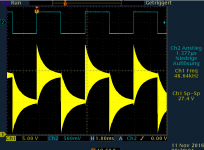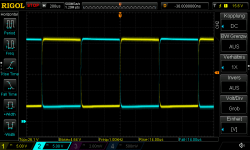Hi all,
I have designed a PCB for the TPA3255 based on the given schematic in the datasheet without PFFB for stereo BTL mode - attached is my design. I've included a microcontroller to monitor the supply rails and bring the TPA3255 out of reset once the supply rails have stabilised.
Once the TPA3255 comes out of reset I see a large amount of oscillation at 50kHz around 16Vpp with and without a load attached (I've tried open circuit, 4R, 8R resistors and a 4R speaker). Does anyone know what could be the cause of this? Particular types of inductors or capacitors in the output filter? Is there any feedback in the system when no PFFB is used? I'm struggling to find anyone else with this problem and not sure where to start really.
Many thanks,
Boscoe
I have designed a PCB for the TPA3255 based on the given schematic in the datasheet without PFFB for stereo BTL mode - attached is my design. I've included a microcontroller to monitor the supply rails and bring the TPA3255 out of reset once the supply rails have stabilised.
Once the TPA3255 comes out of reset I see a large amount of oscillation at 50kHz around 16Vpp with and without a load attached (I've tried open circuit, 4R, 8R resistors and a 4R speaker). Does anyone know what could be the cause of this? Particular types of inductors or capacitors in the output filter? Is there any feedback in the system when no PFFB is used? I'm struggling to find anyone else with this problem and not sure where to start really.
Many thanks,
Boscoe
Attachments
Hi,
People cannot read the schematic or the board as they are not in PDF format.
50kHz sounds very much like the output filter cut off frequency for a class D amplifier.
Regards,
Shadders.
People cannot read the schematic or the board as they are not in PDF format.
50kHz sounds very much like the output filter cut off frequency for a class D amplifier.
Regards,
Shadders.
Hi,
A quick check shows only one large reservoir capacitor for PVDD_CD and none for PVDD_AB, where the TI EVM module is symmetrical here, and closer to the relevant pins.
Since there is no PFFB feedback, and the input traces "seem" to be not close to the output, then my approach is to look at the power supply side, or could it be a ground layout issues ?
Regards,
Shadders.
A quick check shows only one large reservoir capacitor for PVDD_CD and none for PVDD_AB, where the TI EVM module is symmetrical here, and closer to the relevant pins.
Since there is no PFFB feedback, and the input traces "seem" to be not close to the output, then my approach is to look at the power supply side, or could it be a ground layout issues ?
Regards,
Shadders.
Hi,
A quick check shows only one large reservoir capacitor for PVDD_CD and none for PVDD_AB, where the TI EVM module is symmetrical here, and closer to the relevant pins.
Since there is no PFFB feedback, and the input traces "seem" to be not close to the output, then my approach is to look at the power supply side, or could it be a ground layout issues ?
Regards,
Shadders.
Hi Shadders, thanks for the reply.
So the large capacitor is in close proximity to all of the PSU power pins. It's joined with a plane on the inner. There is also a large ground plane, too, which could be a source of the issues.
They are fully shielded if that makes any difference.The coils are too close imo.
Hi,
Can you plot the waveform between terminals ( the ones connected to the speakers) ?
Regards,
Shadders.
Can you plot the waveform between terminals ( the ones connected to the speakers) ?
Regards,
Shadders.
Hi,
The gain of the TPA3255 is 21.5dB (voltage gain, 11.88x) so unless there is a peak voltage of 1.36volts on the input, then the oscillation has to be internal to the IC and output components/PCB design ?
Did you purchase the IC from a reputable source such as Mouser, Farnell, RS or other ?
Regards,
Shadders.
The gain of the TPA3255 is 21.5dB (voltage gain, 11.88x) so unless there is a peak voltage of 1.36volts on the input, then the oscillation has to be internal to the IC and output components/PCB design ?
Did you purchase the IC from a reputable source such as Mouser, Farnell, RS or other ?
Regards,
Shadders.
A substandtial gain peak around 50kHz is normal in a TPA-3255 standard setup due to the self-resonating frequency of the output tank. You will find that ringing as well as well by driving the input with a square wave instead of a sine. So no surprise here.Hi all,
I have designed a PCB for the TPA3255 based on the given schematic in the datasheet without PFFB for stereo BTL mode - attached is my design. I've included a microcontroller to monitor the supply rails and bring the TPA3255 out of reset once the supply rails have stabilised.
Once the TPA3255 comes out of reset I see a large amount of oscillation at 50kHz around 16Vpp with and without a load attached (I've tried open circuit, 4R, 8R resistors and a 4R speaker). Does anyone know what could be the cause of this? Particular types of inductors or capacitors in the output filter? Is there any feedback in the system when no PFFB is used? I'm struggling to find anyone else with this problem and not sure where to start really.
Many thanks,
Boscoe
Did you ever find a square response plot of TPA-3255? Not? TI-people are smart you see!
I append a square plot of the original TPA-3255 EVM I captured in 2016. This started me investigating post-filter-feedback. Resulting in a much friendlier pulse response.
I append a square plot of the original TPA-3255 EVM I captured in 2016. This started me investigating post-filter-feedback. Resulting in a much friendlier pulse response.
Attachments
Yes I will do this however I'm away from the lab for Christmas now 🙁 I will do ASAPHi,
Can you plot the waveform between terminals ( the ones connected to the speakers) ?
Regards,
Shadders.
Wow this is amazing information.Did you ever find a square response plot of TPA-3255? Not? TI-people are smart you see!
I append a square plot of the original TPA-3255 EVM I captured in 2016. This started me investigating post-filter-feedback. Resulting in a much friendlier pulse response.
I did apply a square wave however the 50kHz oscillation I see is constant - not decaying like in your plots.
Do you have any tips on reducing the oscillation?
Yes, but as I am too busy at the moment I will come back later. Any way, a persistant oscillation must not occur and may be caused by a poor/faulty (layout?) design.Wow this is amazing information.
I did apply a square wave however the 50kHz oscillation I see is constant - not decaying like in your plots.
Do you have any tips on reducing the oscillation?
You may follow this thread from 2016: https://www.diyaudio.com/community/threads/tpa3255-all-about-diy-discussion-design-etc.287470/page-4
Yes, but as I am too busy at the moment I will come back later. Any way, a persistant oscillation must not occur and may be caused by a poor/faulty (layout?) design.
That would be awesome! Thank you!
Have a few ideas on how to solve the issue at the moment:
1. Snubbers on the output of the half bridge. I'm using very low ESR caps and inductors so the Q of the filter is naturally high, hopefully reducing the input excitement could help.
2. Using a "differentiating" capacitor as described in this paper: https://stromrichter.org/attachment.php?aid=3349
3. Add small series resistor in the capacitor of the LC filter to reduce the Q.
If none of these fix the issue I think it'll be back to the drawing board with this design. I imagine the issue would lay in the layout of the PCBs.
Nice that you discovered us. I recommend variant 2, just because I am the author of these contributions and the differenciating feedback was my idea. And meanwhile there is nothing I have to add from my side. Snubbers will burn when you drive the amp with sufficciant 50kHz input. And if you don't - you do not need them😉
Last edited:
Once I created a quite simple spice model that reproduces these effects surprisingly well. Should be inside that thread, too.Well, I recommend variant 2, just because I am the author of these contributions. And meanwhile there is nothing I have to add from my side. Snubbers will burn when you drive the amp with sufficciant 50kHz input. And if you don't - you do not need them😉
Last edited:
- Home
- Amplifiers
- Class D
- TPA3255 oscillation issues

